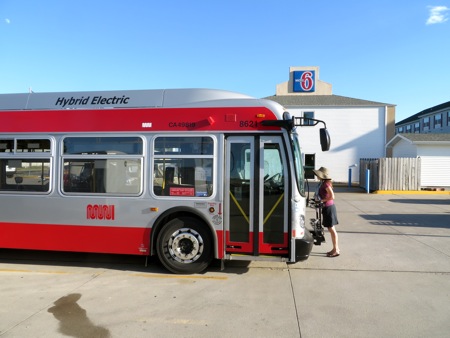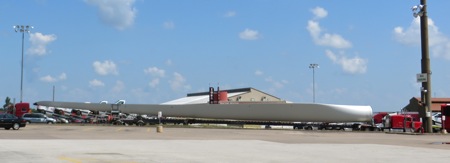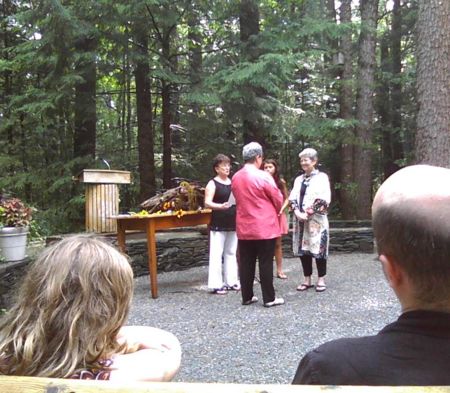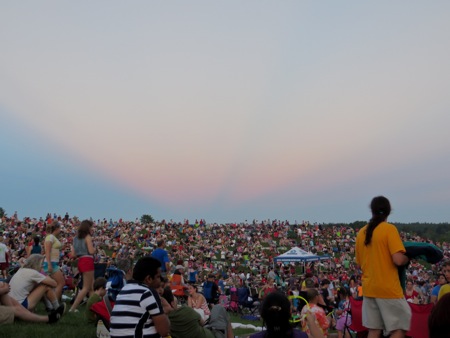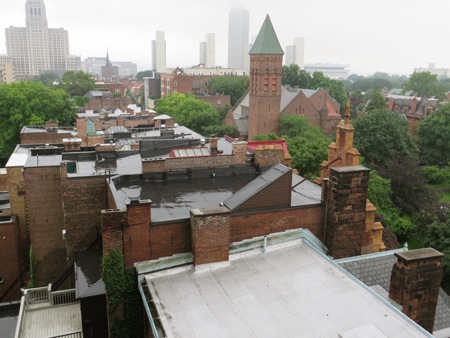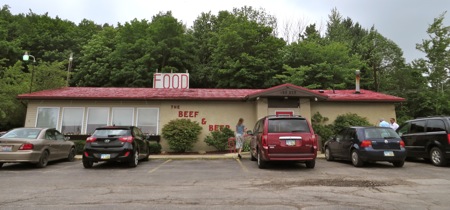By the time we got to the Wyoming border, Carol said she was ready to leave Nebraska. I didn’t say so, but I enjoyed the drive through Nebraska. Near Kearney, I liked the way the highway followed the broad flat valley of the Platte River, every so often crossing over one channel of the river or another, passing between green fields of corn and hay fields and lines of trees along the river channels and the very occasional small city. As we got further west, we saw fewer and fewer trees, and more cattle, and here and there a field of golden wheat. The land gradually rose up and up until we were in the high plains, and most of the land was range land. Now and again we passed cattle, mostly clustered around stock ponds in the heat of the day, and I thought about the story that I had read in yesterday’s issue of the Kearney Hub — “125th year, 230th issue”; “At the center of Nebraska life since 1888” — that told how the U.S. Farm Service is going to allow “emergency grazing on about 900,000 acres in Nebraska because of the ongoing lack of forage for livestock”; Western Nebraska is one of the regions where emergency grazing will be allowed, for conditions continue to be drier than normal, even though “conditions appeared to improve at the beginning of the year.”
Once we got into Wyoming, the scenery did get more dramatic. Not long after we passed over the border, we saw sagebrush growing by the side of the highway, and not long after that we saw our first oil derrick bobbing slowly up and down, and then we caught our first sight of tall mountains in the blue distance. We drove past strange rock formations, and watched the railroad wind its way around the sides of hills and buttes. The railroad reminded me of something we saw yesterday: As we drove out of Yankton, South Dakota, before we crossed over the Missouri River on U.S. Route 81, we had to stop at a railroad crossing for two Union Pacific trains to go by; the train headed west consisted of a long line of empty hopper cars, and the train headed east consisted of a long line of hopper cars filled with coal; I suspected that the coal came from the huge Powder River Basin mines on federal lands in Wyoming, since something like eighty train loads of coal come out of Powder River Basin each day.
We stopped in Laramie to visit the food coop there, and stock up on good food. We happened to arrive just when the farmer’s market was taking place, so we wandered around, talking to people in the various booths. Carol got a small bag of summer apples, and some spinach. I got some raw honey and a loaf of olive bread. Carol got some raspberry leaf tea, and an inexpensive necklace made out of a seashell by the nice young man who sold it to her. I found Second Story Books in the next block, browsed for a while, and came away with a biography of Hans-Georg Gadamer, and a book published by the University of Nebraska Press written by a man who had traveled all over the Great Plains for several months, stopping in small towns and talking with whoever came his way. We finally made it to Big Hollow Coop. The man who took our money was from Jackson, California, and had come to Laramie because his girlfriend was in graduate school there. He told us that Big Hollow is the only coop in the whole state, which surprised me; I expected that there would at least be one in Cheyenne.
We stopped to eat our dinner at a highway rest area outside Laramie. It was very windy, but the picnic table had brick walls surrounding three sides, and a wooden roof, so we could shelter from the wind. A pair of Barn Swallows was also taking shelter in the picnic, and they had built their nest up in the rafters; I could just see one swallow’s tail projecting out a little beyond the mud walls of the nest.
We stopped just before sunset at a parking area just before the exit for Creston Junction, Wyoming, and got out to stretch our cramped legs. We looked out over the sagebrush tinged gold by the setting sun, the mountains in the distance now turning pink and purple, the picturesque white clouds — and I realized something out in the sagebrush was looking at me. “See that?” I said to Carol. “An antelope.” She spotted two more. One of them looked at us, saw that we were too far away to be a threat, grazed on some sagebrush, and began moving west; the other two were also moving west, heading towards the setting sun.


